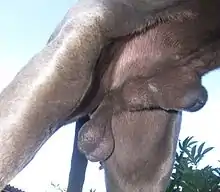Almost all mammal penises have foreskins or prepuces,[1] although in non-human cases, the foreskin is usually a sheath (sometimes called the preputial sheath,[2] praeputium[3] or penile sheath[4]) into which the whole penis is retracted. In koalas, the foreskin contains naturally occurring bacteria that play an important role in fertilization.[5] In some bat species, the prepuce contains an erectile tissue structure called the accessory corpus cavernosus.[6]

During musth, a male elephant may urinate with the penis still in the sheath, which causes the urine to spray on the hind legs.[7]
Male dogs have a conspicuous penis sheath.[8]

In stallions, the retractor penis muscle contracts to retract the stallion's penis into the sheath and relaxes to allow the penis to extend from the sheath.[9]
The penis sheath of a male axis deer is elongated and urine-stained. When rubbing trees with their horns, these stags sometimes move the penis back and forth rapidly inside its sheath.[10] Male bison and fallow deer have tufts of fur at the end of their penis sheaths.[11]
In rodents, the length of the prepuce is related to urine marking behavior.[12]
See also
- Horse sheath cleaning
- Preputial glands, glands which are found in the prepuce of some male mammals
References
- ↑ Fahmy, Mohamed A. Baky. "Prepuce." Rare Congenital Genitourinary Anomalies. Springer Berlin Heidelberg, 2015. 33-41.
- ↑ Edward C. Feldman (2004). Canine and feline endocrinology and reproduction. Elsevier Health Sciences. pp. 934–. ISBN 978-0-7216-9315-6. Archived from the original on 31 December 2013. Retrieved 25 April 2013.
- ↑ Horst Erich König; Hans-Georg Hans-Georg; H. Bragulla (2007). Veterinary Anatomy of Domestic Mammals: Textbook and Colour Atlas. Schattauer Verlag. ISBN 978-3-7945-2485-3. Archived from the original on 2016-05-11. Retrieved 2019-12-13.
- ↑ The behavior guide to African mammals: including hoofed mammals, carnivores, primates. University of California Press. 1991. pp. 116–. ISBN 978-0-520-08085-0. Retrieved 25 April 2013.
penile sheath OR penis sheath OR prepuce.
- ↑ "UQ researchers unlock another koala secret". Uq.edu.au. 2001-05-09. Archived from the original on 2013-05-12. Retrieved 2012-07-16.
- ↑ Elizabeth G. Crichton; Philip H. Krutzsch (12 June 2000). Reproductive Biology of Bats. Academic Press. pp. 104–. ISBN 978-0-08-054053-5.
- ↑ Sukumar, pp. 100–08.
- ↑ George B. Schaller (15 October 2009). The Serengeti Lion: A Study of Predator-Prey Relations. University of Chicago Press. pp. 329–. ISBN 978-0-226-73660-0. Archived from the original on 28 May 2013. Retrieved 10 February 2013.
- ↑ "The Stallion: Breeding Soundness Examination & Reproductive Anatomy". University of Wisconsin-Madison. Archived from the original on 2007-07-16. Retrieved 7 July 2007.
- ↑ Valerius Geist (1998). Deer of the World: Their Evolution, Behaviour and Ecology. Stackpole Books. ISBN 978-0-8117-0496-0. Archived from the original on 23 June 2016. Retrieved 11 May 2013.
- ↑ Fiona Reid (15 November 2006). Peterson Field Guide to Mammals of North America: Fourth Edition. Houghton Mifflin Harcourt. ISBN 978-0-547-34553-6. Archived from the original on 23 June 2016. Retrieved 11 May 2013.
- ↑ Maruniak, J. A., Claude Desjardins, and F. H. Bronson. "Adaptations for urinary marking in rodents: Prepuce length and morphology Archived 2018-07-20 at the Wayback Machine." Journal of Reproduction and Fertility 44.3 (1975): 567-570.
Further reading
- Heide Schatten; Gheorghe M. Constantinescu (21 March 2008). Comparative Reproductive Biology. John Wiley & Sons. ISBN 978-0-470-39025-2.
- Peter J Chenoweth; Steven Lorton (30 April 2014). Animal Andrology: Theories and Applications. CABI. ISBN 978-1-78064-316-8.
- Kristin J. Holtgrew-Bohling (12 March 2014). Large Animal Clinical Procedures for Veterinary Technicians. Elsevier Health Sciences. ISBN 978-0-323-29035-7.
- Mating Reflexes. Ardent Media. 1974. pp. 84–. ISBN 978-0-8422-7236-0. Retrieved 11 May 2013.
- N. Norman Edward Robinson; Kim A. Sprayberry (2009). Current Therapy in Equine Medicine 6. Elsevier Health Sciences. pp. 760–. ISBN 978-1-4160-5475-7. Retrieved 11 May 2013.
- Auguste Chauveau (1887). The Comparative anatomy of the domesticated animals. D. Appleton & Company. pp. 869–. Retrieved 11 May 2013.
penile sheath OR penis sheath OR preputial sheath OR prepuce.
- Richard Doty (1 January 1976). Mammalian Olfaction, Reproductive Processes, and Behavior. Elsevier Science. pp. 126–. ISBN 978-0-323-15450-5. Retrieved 11 May 2013.
- Catherine Lamm; Chelsea Makloski (28 May 2012). Theriogenology, An Issue of Veterinary Clinics: Small Animal Practice. Elsevier Health Sciences. pp. 309–. ISBN 978-1-4557-4447-3. Retrieved 11 May 2013.
- Donald Chapman; Norma Chapman (1975). Fallow Deer: Their History, Distribution, and Biology. Dalton. ISBN 978-0-900963-50-6. Retrieved 16 May 2013.
- David M. Shackleton (1999). Hoofed mammals of British Columbia. UBC Press. ISBN 978-0-7748-0728-9. Retrieved 16 May 2013.
- Leonard Lee Rue (2 August 2004). The encyclopedia of deer: your guide to the world's deer species including whitetails, mule deer, caribou, elk, moose, and more. Voyageur Press. ISBN 978-0-89658-590-4. Retrieved 16 May 2013.
- Heather Smith Thomas (2009). The Cattle Health Handbook: Preventive Care, Disease Treatments & Emergency Procedures for Promoting the Well-being of Your Beef Or Dairy Herd. Storey Pub. ISBN 978-1-60342-090-7. Retrieved 18 May 2013.
- Thomas J. Divers (2008). Rebhun's diseases of dairy cattle. Elsevier Health Sciences. ISBN 978-1-4160-3137-6. Retrieved 18 May 2013.
- Debra M. Eldredge; Delbert G. Carlson; Liisa D. Carlson; James M. Giffin (7 January 2008). Cat Owner's Home Veterinary Handbook. John Wiley & Sons. ISBN 978-0-470-22767-1. Retrieved 7 June 2013.